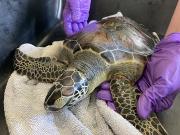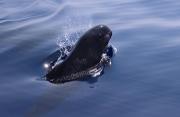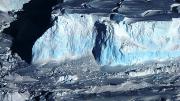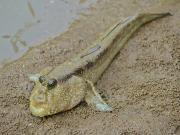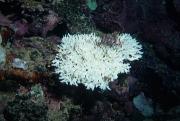Radio Program
Our regular Science and the SeaTM radio program presents marine science topics in an engaging two-minute story format. Our script writers gather ideas for the radio program from the University of Texas Marine Science Institute's researchers and from our very popular college class, Introduction to Oceanography, which we teach to hundreds of non-science majors at The University of Texas at Austin every year. Our radio programs are distributed at to commercial and public radio stations across the country.
The groups that rescue and treat sick or injured sea turtles take advantage of a lot of modern science: the latest medications, CAT scans, laser surgery, and much more. But some of those groups also use one of the most ancient treatments of all: honey. Some even keep their own beehives to maintain a fresh supply.
Honey has been used as a treatment for people for thousands of years. It’s been applied to cuts and scrapes, burns, and other wounds. And both ancient accounts and modern research tell us that it can help heal a variety of injuries.
Fish make a lot of noise. They grunt, click, pop, squeak, groan, buzz, and make many other sounds. And they’ve probably been talking for a long time.
Scientists have long known that some fish make sounds. In fact, some fish are named for their sounds: drums ... grunts ... and croakers ... among others. Like land animals, they use sound to attract mates, avoid predators, find prey, and defend their territory.
Covid-19 has impacted just about every aspect of life. One of those impacts is ocean pollution. Millions of masks, gloves, and other pieces of debris have washed up on beaches or into the open ocean. That’s a problem not just for human life, but for all life in or around the oceans.
Long-finned pilot whales like to talk. They produce a wide variety of clicks, buzzes, whistles, and calls. That allows them to identify friends and family, even over long distances. And it may also help keep them safe from killer whales.
Long-finned pilot whales are fairly small as whales go. They can reach lengths of 20 to 25 feet, and weigh two or three tons. They have a stout body, with long, curving flippers. They live in pods of a dozen or so, headed by the mother of the clan. And the pods can cluster in groups of hundreds of animals.
In April of 1822, the ships Pearl and Hermes were hunting whales far from the main islands of Hawaii when they found something bigger. They ran aground on an atoll—a ring of coral reefs atop a dead undersea volcano. The sailors made it to one of the atoll’s tiny islands, where they lived for months before rescue. And today, the atoll is named for their ships.
Seagrass beds face many threats these days: pollution, reduced habitat, and stronger tropical storms, to name a few. Another is disease. As the oceans get warmer, organisms that cause diseases multiply quickly. They attack the grass, killing or weakening not just individual plants, but entire meadows.
A recent study says that seaweed grown in farms could be a twofer: It could reduce the pollution in estuaries while producing nutritious food.
Seaweed is grown commercially in some parts of the world, but it’s been slow to catch on in the United States. It’s picking up in some parts of the country, though—especially Maine and Alaska.
Earth’s glaciers are melting. But some are in a bigger hurry than others. A glacier in Antarctica is adding water to the oceans faster than any other. More than a trillion tons of its ice have melted since 2000. That’s raised global sea level by a few millimeters. And the glacier could add a lot more to the oceans in the decades ahead.
Thwaite’s Glacier covers an area as big as Florida. And it has a nickname: the Doomsday Glacier. A collapse could raise sea level by as much as three feet.
For most fish, there’s one way to breathe. The fish takes in water through its mouth and passes it over its gills. Tiny blood vessels in the gills absorb oxygen from the water and send it through the fish’s body. If the fish leaves the water for more than a few minutes, it suffocates—it can’t breathe oxygen from the air.
Warming oceans have damaged or destroyed many coral reefs. But some appear to be adapting to the warm-up. Reef systems in a part of the central Pacific Ocean, for example, have suffered less damage from a couple of recent underwater heatwaves than from an earlier one. That could mean that coral offspring that are more resistant to heat are taking hold.

